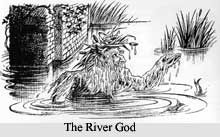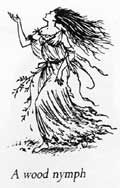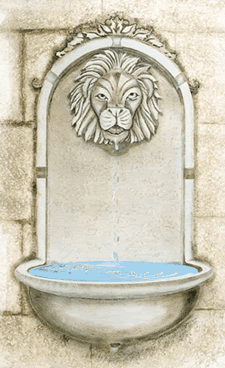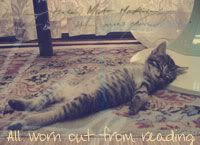Aslan Roars
The girls watched them out of sight, standing close beside Aslan. The light was changing. Low down in the east, Aravir, the morning star of Narnia, gleamed like a little moon. Aslan, who seemed larger than before, lifted his head, shook his mane, and roared.
The sound, deep and throbbing at first like an organ beginning on a low note, rose and became louder, and then far louder again, till the earth and air were shaking with it. It rose up from that hill and floated across all Narnia. Down in Miraz's camp men woke, stared palely in one another's faces, and grasped their weapons.
 Down below that in the Great River, now at its coldest hour, the heads and shoulders of the nymphs, and the great weedy-bearded head of the river-god, rose from the water. Beyond it, in every field and wood, the alert ears of rabbits rose from their holes, the sleepy heads of birds came out from under wings, owls hooted, vixens barked, hedgehogs grunted, the trees stirred. In towns and villages mothers pressed babies close to their breasts, staring with wild eyes, dogs whimpered, and men leaped up groping for lights. Far away on the northern frontier the mountain giants peered from the dark gateways of their castles.
Down below that in the Great River, now at its coldest hour, the heads and shoulders of the nymphs, and the great weedy-bearded head of the river-god, rose from the water. Beyond it, in every field and wood, the alert ears of rabbits rose from their holes, the sleepy heads of birds came out from under wings, owls hooted, vixens barked, hedgehogs grunted, the trees stirred. In towns and villages mothers pressed babies close to their breasts, staring with wild eyes, dogs whimpered, and men leaped up groping for lights. Far away on the northern frontier the mountain giants peered from the dark gateways of their castles. What Lucy and Susan saw was a dark something coming to them from almost every direction across the hills.
 It looked first like a black mist creeping on the ground, then like the stormy waves of a black sea rising higher and higher as it came on, and then, at last, like what it was woods on the move. All the trees of the world appeared to be rushing towards Aslan. But as they drew nearer they looked less like trees; and when the whole crowd, bowing and curtsying and waving thin long arms to Aslan, were all around Lucy, she saw that it was a crowd of human shapes. Pale birch-girls were tossing their heads, willowwomen pushed back their hair from their brooding faces to gaze on Aslan, the queenly beeches stood still and adored him, shaggy oak-men, lean and melancholy elms, shockheaded hollies (dark themselves, but their wives all bright with berries) and gay rowans, all bowed and rose again, shouting, "Aslan, Aslan!" in their various husky or creaking or wave-like voices.
It looked first like a black mist creeping on the ground, then like the stormy waves of a black sea rising higher and higher as it came on, and then, at last, like what it was woods on the move. All the trees of the world appeared to be rushing towards Aslan. But as they drew nearer they looked less like trees; and when the whole crowd, bowing and curtsying and waving thin long arms to Aslan, were all around Lucy, she saw that it was a crowd of human shapes. Pale birch-girls were tossing their heads, willowwomen pushed back their hair from their brooding faces to gaze on Aslan, the queenly beeches stood still and adored him, shaggy oak-men, lean and melancholy elms, shockheaded hollies (dark themselves, but their wives all bright with berries) and gay rowans, all bowed and rose again, shouting, "Aslan, Aslan!" in their various husky or creaking or wave-like voices.~C.S. Lewis, Prince Caspian, (1951)
Illustrations by Pauline Baynes
______________________________
On this day:
1951 Prince Caspian (the second volume written in The Chronicles of Narnia) is published by Geoffrey Bles, London.
______________________________
Pauline Baynes on Lewis:
"As I remember, he only once asked for an alteration-- and then with many apologies--when I (with my little knowledge) had drawn one of the characters rowing a boat facing the wrong direction!
When he did criticize, it was put over so charmingly, that it wasn't a criticism, i.e. I did the drawings as best I could...and didn't realize how hideous I had made the children--they were as nice as I could get them--and Dr. Lewis said, when we were starting on the second book, 'I know you made the children rather plain--in the interests of realism--but do you think you could possibly pretty them up a little now?'"
~Pauline Baynes, Letter to Walter Hooper, August 15, 1967




4 Comment(s):
*Adds to list of scenes I wanna see on the big screen*
Great portion! Do you think it'll be included in the movie?
I know what you mean, Anamire, this reminds me of Tolkien's Ents too!
I think that both Tolkien and Lewis drew on the Celtic myths of the driads and the water nymphs, for their inspiration.
Also, one time on sacred-texts.com I found a reference to a river-god from the Roman time period (maybe you know this). They used to throw old men into the river as sacrifices to appease the river-god about building a bridge over him.
Hmmm...I wonder, Joelle.
Considering how difficult the Treebeard scenes were, they may end up CGI'ing them, if they use it in the movie. Is it definite that they are working on the Prince Caspian script?
Here's a quote from Sacred-Texts.com:
"On March sixteenth and seventeenth, a solemn procession made a circuit of twenty-seven chapels called "Argei" located in various parts of the city of Rome. Rush puppets, bearing the same name, and resembling bound men, were made in the chapels, where they reposed until May fourteenth or fifteenth, when the pontiffs and the generals (praetores) carried them in procession to the Sublician Bridge over the Tiber. Here the Vestals threw them into the river in the presence of the generals and the wife of the Priest of Jupiter, who was in mourning. Ovid records several explanations of the rite which were current in his day: In ancient times, two men had been sacrificed to Saturn, the god of sowing, and thrown into the Tiber; with the coming to Italy of Hercules, who substituted straw puppets for the men, the practice of throwing puppets into the river began. Another account tells how the younger generation of Romans, in order to secure the voting privilege for themselves alone, threw all men who were over sixty years of age from certain bridges, probably--as we read in Festus, who tells the same story--the bridges in the Plain of Mars over which the Romans passed when going to vote...
An attempt has been made in modern times to revive the ancient Roman explanation of this rite--that the puppets represented, by substitution, a survival of the times when old men had actually been sacrificed and thrown into the Tiber, possibly to pacify the river god for the building of the bridge."
~TABOO, MAGIC, SPIRITS: A STUDY OF PRIMITIVE ELEMENTS IN ROMAN RELIGION, Chapter IV, "Magic Acts: The General Principles" BY ELI EDWARD BURRISS 1931
Here's a link to the page: Sacred-texts.com
Post a Comment
<< Home